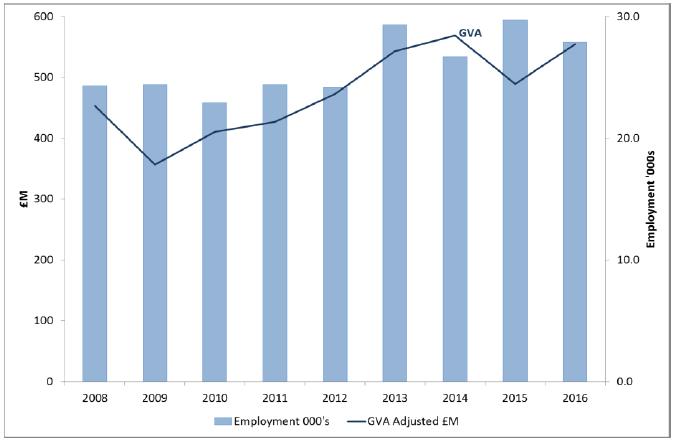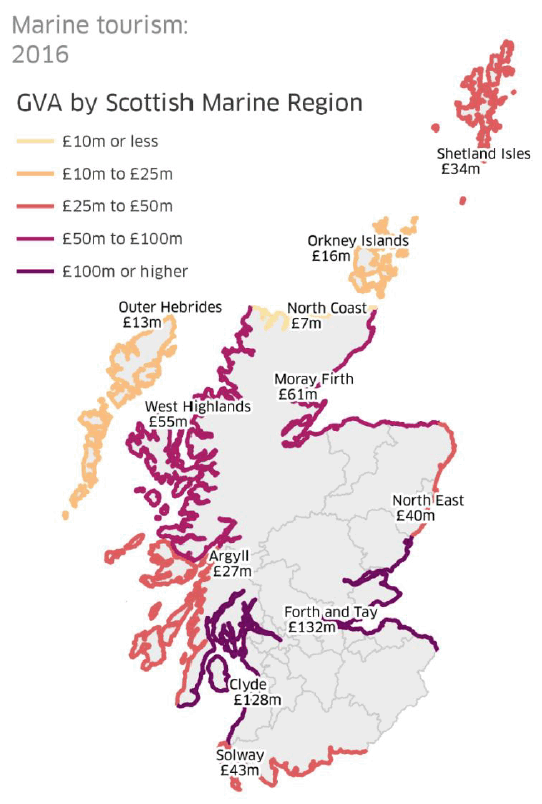Scotland's marine economic statistics 2016
The publication presents economic statistics for industrial categories defined as part of the marine sector.
This document is part of a collection
11. Marine Tourism
11.1 Introduction
In 2017, Marine Scotland developed the methodology for estimating marine tourism and recreation, as distinct from all tourism. SABS SIC codes were identified as being related to tourism and recreation. Then, all tourism businesses located in postcodes within 100 metres of the coastline were assumed to be engaging in marine tourism and recreation or dependent on the marine environment. While this may include some businesses that are not marine-related, and not include some that are marine-related, it provides a reasonable and replicable method of estimating marine tourism and recreation businesses with existing data. Details are contained in Annex B: Methodology and source data.
11.2 Key economic points
In 2016 marine tourism generated £554 million GVA: accounting for 0.4 % of the overall Scottish economy, and 14 % of the marine economy.
In terms of employment, marine tourism provided employment for 27,900 workers, contributing 1.1 % to total Scottish employment, the biggest marine economy employer accounting for 37 % of the marine economy employment.
Scottish tourism as a whole was estimated as producing £3.9 billion GVA in 2016. Thus marine tourism is estimated to account for around 14% of all Scottish tourism.
11.3 Marine tourism – trends
While the marine tourism methodology was developed in 2017, figures have been estimated retrospectively, showing that, between 2008 and 2016 marine tourism GVA (adjusted to 2016 prices) increased by 22% and employment increased by 15%.
The latest figures show a 13% increase in marine tourism GVA between 2015 and 2016, though employment dropped by 6% in that time.
Table 16: Marine tourism - GVA, turnover, employment and GVA per head, 2008 to 2016 (2016 prices)
| Year | GVA £M | Turnover £M | Employment Headcount 000's | GVA Per Head £ |
|---|---|---|---|---|
| 2008 | 453 | 892 | 24.30 | 18,647 |
| 2009 | 357 | 746 | 24.40 | 14,616 |
| 2010 | 410 | 830 | 22.90 | 17,923 |
| 2011 | 427 | 871 | 24.40 | 17,493 |
| 2012 | 473 | 937 | 24.20 | 19,530 |
| 2013 | 543 | 996 | 29.30 | 18,519 |
| 2014 | 569 | 1,013 | 26.70 | 21,295 |
| 2015 | 489 | 913 | 29.70 | 16,464 |
| 2016 | 554 | 1,031 | 27.90 | 19,864 |
Figure 16 : Marine tourism - GVA and employment (headcount), 2008 to 2016 (2016 prices)

Employment in Marine tourism and recreation contributes strongly to employment in the marine economy in Scotland, though GVA is a smaller proportion of Scotland’s marine economy GVA, possibly reflecting the seasonal nature of tourism and recreation and the part time nature of employment.
11.4 Marine tourism by geography
The 2016 economic values were attributed to Scottish Marine Regions (attribution by local authority is partially disclosive due to the small quantity of data). While SMRs are marine geographies, marine tourism is earned on land, therefore Figure 17 shows outputs around the coast.
The Forth and Tay region contributed the largest marine tourism GVA in 2016, while the Clyde region contributed higher turnover and employment.
Table 17: Marine tourism - GVA, turnover and employment, by SMR, 2016
Ranked in order of GVA.
| SMR | GVA £M | Turnover £M | Employment Headcount ‘000s |
|---|---|---|---|
| Forth and Tay | 132 | 221 | 6.3 |
| Clyde | 128 | 249 | 7.3 |
| Moray Firth | 61 | 120 | 3.4 |
| West Highlands | 55 | 90 | 3.2 |
| Solway | 43 | 93 | 1.4 |
| North East | 40 | 74 | 2.0 |
| Shetland Isles | 34 | 72 | 0.9 |
| Argyll | 27 | 47 | 1.7 |
| Orkney Islands | 16 | 27 | 0.6 |
| Outer Hebrides | 13 | 28 | 0.8 |
| North Coast | 7 | 10 | 0.4 |
| Grand Total | 554 | 1,031 | 28.0 |
Figure 17: Marine tourism GVA by Scottish Marine Region, 2016

Scottish Government (Marine Scotland) 2018
Contains National Statistics data ©
Crown copyright and database right
Contact
There is a problem
Thanks for your feedback